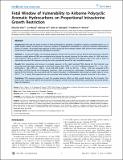| dc.contributor.author | Choi, Hyunok | |
| dc.contributor.author | Wang, Lu | |
| dc.contributor.author | Lin, Xihong | |
| dc.contributor.author | Spengler, John D. | |
| dc.contributor.author | Perera, Frederica P. | |
| dc.date.accessioned | 2012-12-13T17:59:00Z | |
| dc.date.issued | 2012 | |
| dc.identifier.citation | Choi, Hyunok, Lu Wang, Xihong Lin, John D. Spengler, and Frederica P. Perera. 2012. Fetal window of vulnerability to airborne polycyclic aromatic hydrocarbons on proportional intrauterine growth restriction. PLoS ONE 7(4): e35464. | en_US |
| dc.identifier.issn | 1932-6203 | en_US |
| dc.identifier.uri | http://nrs.harvard.edu/urn-3:HUL.InstRepos:10054145 | |
| dc.description.abstract | Background: Although the entire duration of fetal development is generally considered a highly susceptible period, it is of public health interest to determine a narrower window of heightened vulnerability to polycyclic aromatic hydrocarbons (PAHs) in humans. We posited that exposure to PAHs during the first trimester impairs fetal growth more severely than a similar level of exposure during the subsequent trimesters. Methods In a group of healthy, non-smoking pregnant women with no known risks of adverse birth outcomes, personal exposure to eight airborne PAHs was monitored once during the second trimester for the entire cohort (n = 344), and once each trimester within a subset (n = 77). Both air monitoring and self-reported PAH exposure data were used in order to statistically estimate PAH exposure during the entire gestational period for each individual newborn. Results: One natural-log unit increase in prenatal exposure to the eight summed PAHs during the first trimester was associated with the largest decrement in the Fetal Growth Ratio (FGR) (−3%, 95% Confidence Interval (CI), −5 to −0%), birthweight (−105 g, 95% CI, −188 to −22 g), and birth length (−0.78 cm, 95% CI, −1.30 to −0.26 cm), compared to the unit effects of PAHs during the subsequent trimesters, after accounting for confounders. Furthermore, a unit exposure during the first trimester was associated with the largest elevation in Cephalization Index (head to weight ratio) (3 μm/g, 95% CI, 1 to 5 μm/g). PAH exposure was not associated with evidence of asymmetric growth restriction in this cohort. Conclusion: PAH exposure appears to exert the greatest adverse effect on fetal growth during the first trimester. The present data support the need for the protection of pregnant women and the embryo/fetus, particularly during the earliest stage of pregnancy. | en_US |
| dc.language.iso | en_US | en_US |
| dc.publisher | Public Library of Science | en_US |
| dc.relation.isversionof | doi:10.1371/journal.pone.0035464 | en_US |
| dc.relation.hasversion | http://www.ncbi.nlm.nih.gov/pmc/articles/PMC3335852/pdf/ | en_US |
| dash.license | LAA | |
| dc.subject | biology | en_US |
| dc.subject | toxicology | en_US |
| dc.subject | toxic agents | en_US |
| dc.subject | chemistry | en_US |
| dc.subject | organic chemistry | en_US |
| dc.subject | organic compounds | en_US |
| dc.subject | aromatic hydrocarbons | en_US |
| dc.subject | hydrocarbons | en_US |
| dc.subject | medicine | en_US |
| dc.subject | epidemiology | en_US |
| dc.subject | environmental epidemiology | en_US |
| dc.subject | lifecourse epidemiology | en_US |
| dc.subject | obstetrics and gynecology | en_US |
| dc.subject | pregnancy | en_US |
| dc.subject | pediatrics | en_US |
| dc.subject | neonatology | en_US |
| dc.subject | public health | en_US |
| dc.subject | child health | en_US |
| dc.subject | environmental health | en_US |
| dc.title | Fetal Window of Vulnerability to Airborne Polycyclic Aromatic Hydrocarbons on Proportional Intrauterine Growth Restriction | en_US |
| dc.type | Journal Article | en_US |
| dc.description.version | Version of Record | en_US |
| dc.relation.journal | PLoS ONE | en_US |
| dash.depositing.author | Spengler, John D. | |
| dc.date.available | 2012-12-13T17:59:00Z | |
| dc.identifier.doi | 10.1371/journal.pone.0035464 | * |
| dash.contributor.affiliated | Choi, Hyunok | |
| dash.contributor.affiliated | Wang, Lu | |
| dash.contributor.affiliated | Spengler, John | |
| dash.contributor.affiliated | Lin, Xihong | |


